AUDI ALLROAD 2000 Owners Manual
Manufacturer: AUDI, Model Year: 2000, Model line: ALLROAD, Model: AUDI ALLROAD 2000Pages: 306, PDF Size: 9.95 MB
Page 251 of 306
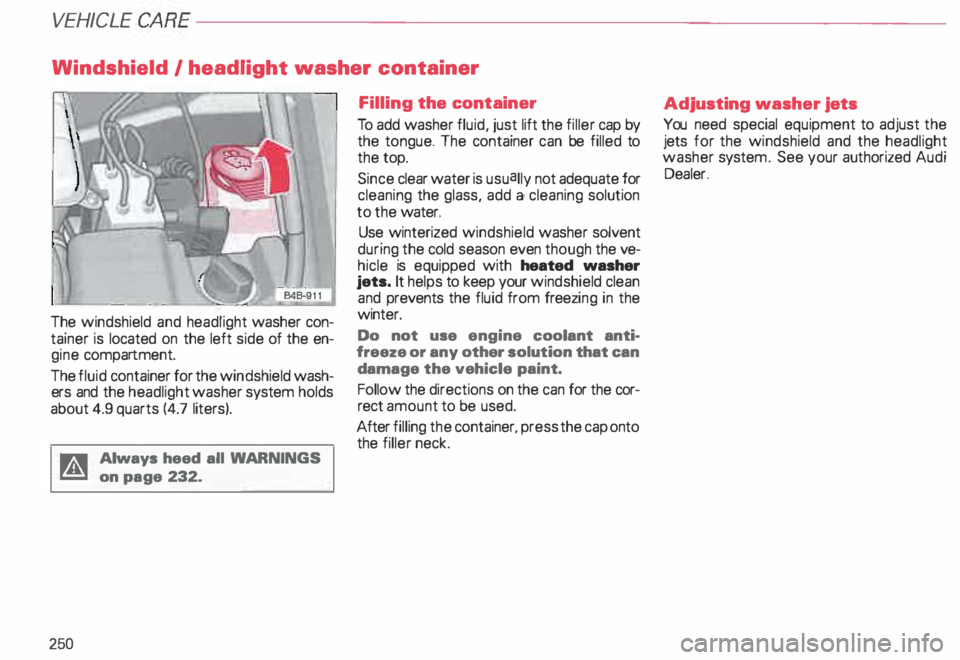
VEHI
CLE CA
RE---------------------------------------------------
Windshield I headlight washer container
The windshield and headlight washer con
tainer is located on the left side of the en
gine compartment.
The fluid container for the windshield wash
ers and the headlight washer system holds
about 4.9 quarts (4.7 liters).
A Always heed all WAR NINGS
� on page 232.
250 Filling
the container
To add washer fluid, just lift the filler cap by
the tongue. The container can be filled to
the top.
Since clear water is usually not adequate for
cleaning the glass, add a cleaning solution
to the water.
Use winterized windshield washer solvent
during the cold season even though the ve
hicle is equipped with heated washer
jets. It helps to keep your windshield clean
and prevents the fluid from freezing in the
winter.
Do not use engine coolant anti·
freeze or any other solution that can
damage the vehicle paint.
Follow the directions on the can for the cor
rect amount to be used.
After filling the container, press the cap onto
the filler neck. Adjusting
washer jets
You need special equipment to adjust the
jets for the windshield and the headlight
washer system. See your authorized Audi
Dealer.
Page 252 of 306
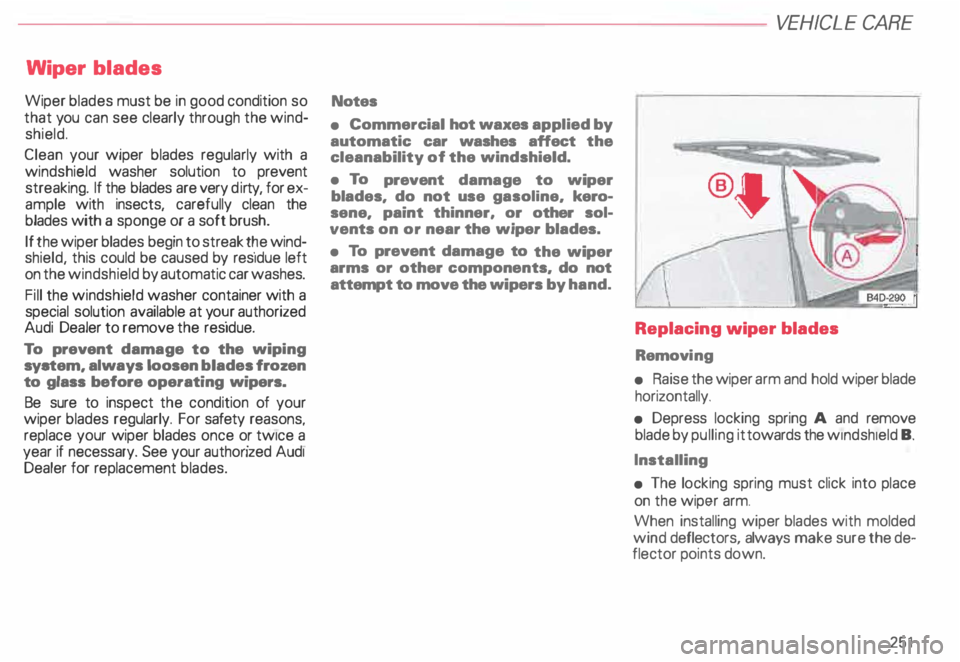
Wiper
blades
Wiper blades must be in good condition so
that you can see clearly through the wind
shield.
Clean your wiper blades regularly with a
windshield washer solution to prevent
streaking. If the blades are very dirty, for ex
ample with insects, carefully clean the
blades with a sponge or a soft brush.
If the wiper blades begin to streak t �e wind
shield, this could be caused by resrdue left
on the windshield by automatic car washes.
Fill the windshield washer container with a
special solution available at yo�r authorized
Audi Dealer to remove the resrdue.
To prevent damage to the wiping
sys tem, always loosen blades frozen
to glass before operating wipers.
Be sure to inspect the condition of your
wiper blades regularly. For safety reasons,
replace your wiper blades once o; twrce a
year if necessary. See your authonzed Audr
Dealer for replacement blades. Notes
• Commercial hot waxes applied by
automatic car washes affect the
cleanability of the windshield.
• To prevent damage to wiper
blades, do not use gasoline, kero
sene, paint thinner, or other sol
vents on or near the wiper blades.
• To prevent damage to the wiper
arms or other components, do not
attempt to move the wipers by hand. VE
HICL E CA RE
Replacing wiper blades
Removi ng
• Raise the wiper arm and hold wiper blade
horizontally.
• Depress locking spring A and remove
blade by pulling it towards the wrndsh1eld B.
Installing
• The locking spring must click into place
on the wiper arm.
When installing wiper blades with molded
wind deflectors, always make sure the de
flector points down.
251
Page 253 of 306
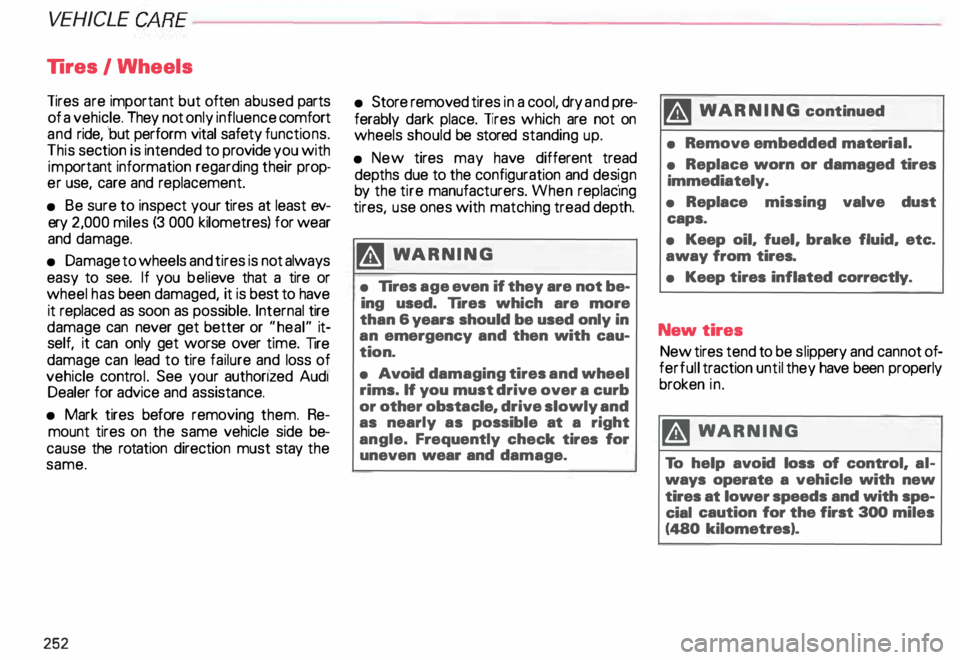
VEHICLE
CARE-------------------------
Tires I Wheels
Tires are important but often abused parts
of a vehicle. They not only influence comfort
and ride, but perform vital safety functio �s.
This section is intended to provide you w1th
imp ortant information regarding their prop
er use, care and replacement.
• Be sure to inspect your tires at least ev
ery 2,000 miles (3 000 kilometres) for wear
and damage.
• Damage to wheels and tires is not always
easy to see. If you believe that a tire or
wheel has been damaged, it is best to have
it replaced as soon as possible. Internal tire
damage can never get better or ': heal" it
self, it can only get worse over t1me. Tire
damage can lead to tire failure and loss of
vehicle control. See your authonzed Aud1
Dealer for advice and assistance.
• Mark tires before removing them. Re
mount tires on the same vehicle side be
cause the rotation direction must stay the
same.
252 •
Store removed tires in a cool, dry and pre
ferably dark place. Tires which are not on
wheels should be stored standing up.
• New tires may have different tread
depths due to the configuration and des!gn
by the tire manufacturers. When replacing
tires, use ones with matching tread depth.
�W ARNING
• Tires age even if they are not be
ing used. Tires which are more
than 6 years should be used only in
an emergency and then with cau
tion.
• Avoid damaging tires and wheel
rims. If you must drive over a curb
or other obstacle, drive slowly and
as nearly as possible at a right
angle. Frequently check tires for
uneven wear and damage. M
WARNIN G continued
• Remove embedded material.
• Replace worn or damaged tires
immediately.
• Replace missing valve dust
caps.
• Keep oil, fuel, brake fluid, etc.
away from tires.
• Keep tires inflated correctly.
New tires
New tires tend to be slippery and cannot of
ferfull traction until they have been properly
broken in.
�W ARNING
To help avoid loss of control, al
ways operate a vehicle with new
tires at lower speeds and with spe
cial caution for the first 300 miles
(480 kilometres).
Page 254 of 306
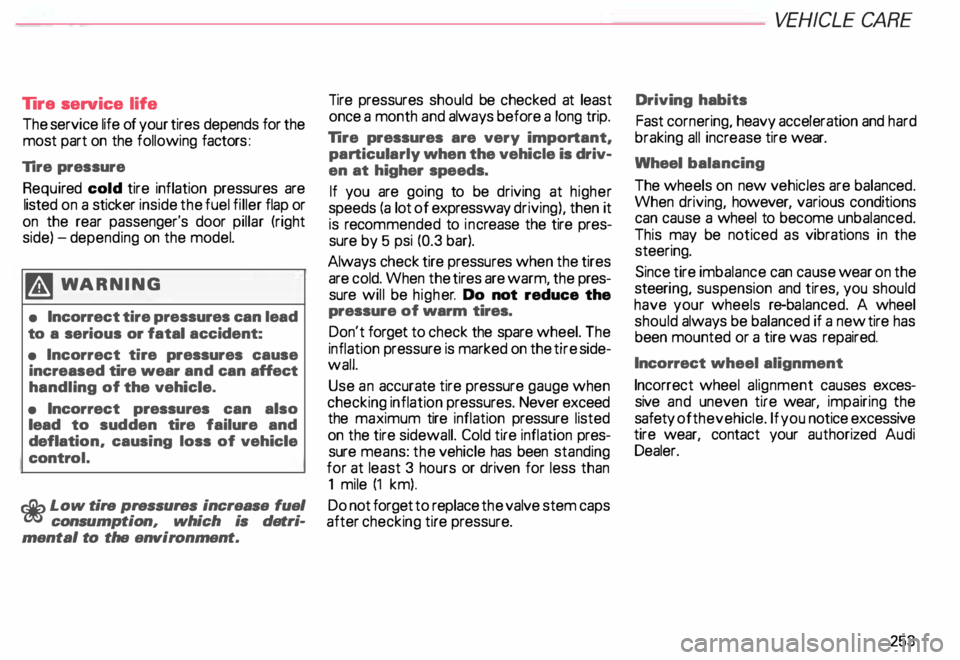
lira
service life
The service life of your tires depends for the
most part on the following factors:
lire pressure
Requir ed cold tire inflation pressures are
listed on a sticker inside the fuel filler flap or
on the rear passenger's door pillar (right
side) -depending on the model.
�W ARNING
• Incorrect tire pressures can lead
to a serious or fatal accident:
• Incorrect tire pressures cause
increased tire wear and can affect
handling of the vehicle.
• Incorrect pressures can also
lead to sudden tire failure and
deflati on, causing loss of vehicle
contr ol.
c£' Low tire pressures increase fuel
consumption, which is detri
mental to the environment. Tire
pressures should be checked at least
once a month and always before a long trip.
Tire pressures are very important,
particularly when the vehicle is driv
en at higher speeds.
If you are going to be driving at higher
speeds (a lot of expressway driving), then it
is rec ommended to increase the tire pres
sure by 5 psi (0.3 bar).
Always check tire pressures when the tires
are cold. When the tires are warm, the pres
sure will be highe r. Do not reduce the
pressure of warm tires.
Don't forget to check the spare wheel. The
inflation pressure is marked on the tire side
wall.
Use an accurate tire pressure gauge when
checking inflation pressures. Never exceed
the maximum tire inflation pressure listed
on the tire sidewall. Cold tire inflation pres
sure means: the vehicle has been standing
for at least 3 hours or driven for less than
1 mile (1 km).
Do not forget to replace the valve stem caps
after checking tire pressure. VE
HICL E CA RE
Driving habits
Fast cornering, heavy acceleration and hard
braking all increase tire wear.
Wheel balancing
The wheels on new vehicles are balanced.
When driving, however, various conditions
can cause a wheel to become unbalanced.
This may be noticed as vibrations in the
steering.
Since tire imbalance can cause wear on the
steeri ng, suspension and tires, you should
have your wheels re-balanced. A wheel
should always be balanced if a new tire has
been mounted or a tire was repaired.
Incorrect wheel alignment
Incorrect wheel alignment causes exces
sive and uneven tire wear, impairing the
safety ofth e veh ide. If you notice excessive
tire wear, contact your authorized Audi
Dealer.
253
Page 255 of 306
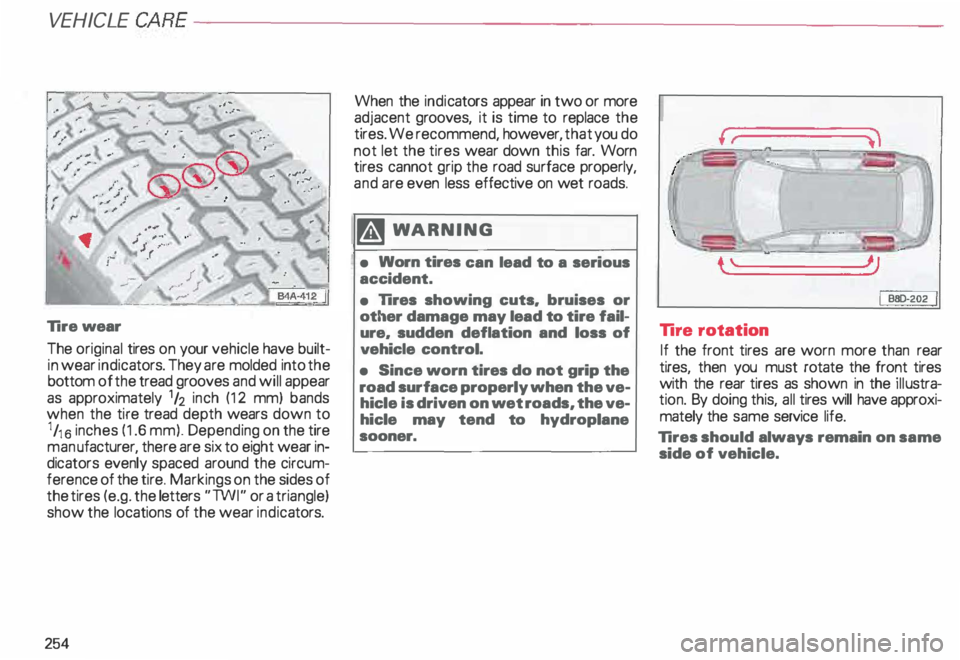
VEHICLE
CARE----------------------------------------------------
Tire wear
The original tires on your vehicle have built
in wear indicators. They are molded into the
bottom of the tread grooves and will appear
as approximately 1h inch (12 mm) bands
when the tire tread depth wears down to
1 /1 6 inches (1.6 mm). Depending on the tire
man ufacturer, there are six to eight wear in
dicators evenly spaced around the circum
ference of the tire. Markings on the sides of
the tires (e.g. the letters "TWI" or a triangle)
show the locations of the wear indicators.
254 When the
indicators appear in two or more
adjacent grooves, it is time to replace the
tires. We recommend, however, that you do
not let the tires wear down this far. Worn
tires cannot grip the road surface properly,
and are even less effective on wet roads.
�W ARNING
• Worn tires can lead to a serious
accident.
• lires showing cuts. bruises or
other damage may lead to tire fail
ure. sudden deflation and loss of
vehicle control.
• Since worn tires do not grip the
road surface properly when the ve
hicle is driven on wet roads, the ve
hicle may tend to hydroplane
sooner. I
BBD-2.02.
I
Tire rotation
If the front tires are worn more than rear
tires, then you must rotate the front tires
with the rear tires as shown in the illustra
tion. By doing this, all tires will have approxi
mately the same service life.
Tires should always remain on same
side of vehicle.
Page 256 of 306
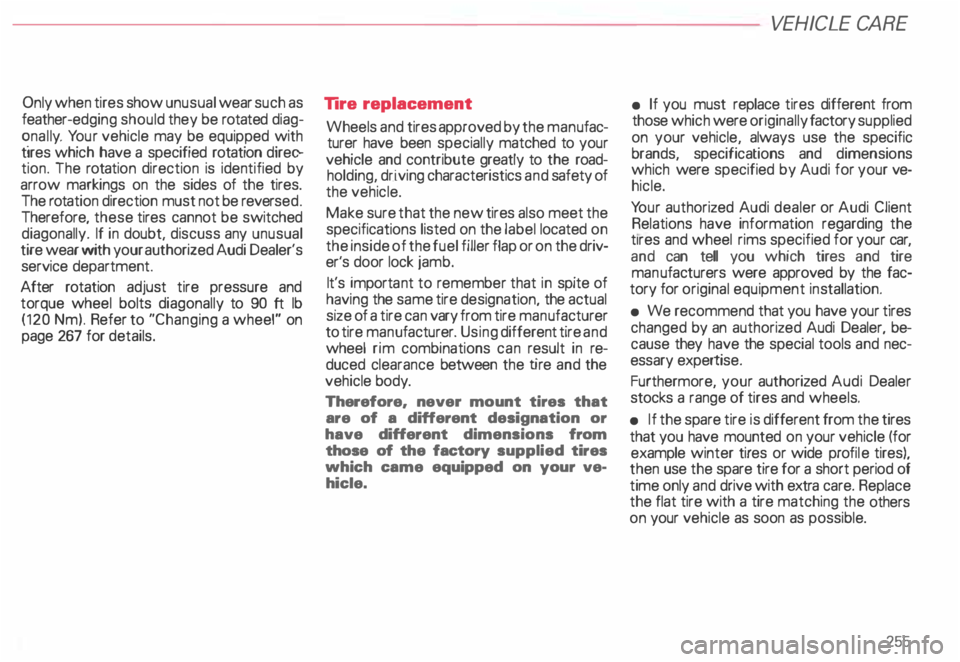
Only
when tires show unusual wear such as
feather-e dging should they be rotated diag
� nall y. Yo ur vehicle may be equipped with
trres which have a specified rotation direc
tion. The rotation direction is identified by
arrow markings on the sides of the tires.
The rotation direction must not be revers ed.
Therefore, these tires cannot be switched
diagonally. If in doubt, discuss any unusual
tire wear with your authorized Audi Dealer's
service department.
After rotation adjust tire pressure and
torque wheel bolts diagonally to 90 tt lb
(120 Nm). Refer to "Changing a wheel" on
page 267 for details. Tire
replacement
Wheels and tires approved by the manu fac
turer have been specially matched to your
vehicle and contribute greatly to the road
holding, driving characteristics and safety of
the vehicle.
Make sure that the new tires also meet the
specifications listed on the label located on
the inside of the fuel filler flap or on the driv
er's door lock jamb.
It's �mporta nt to remember that in spite of
h �vrng the same tire designation, the actual
s1ze of a tire can vary from tire man ufacturer
to tire man ufacturer. Using different tire and
wheel rim combinations can result in re
duced clearance between the tire and the
vehicle body.
Therefore, never mount tires that
are of a different designation or
have different dimensions from
those of the factory supplied tires
which came equipped on your ve
hicle. VE
HICLE CARE
• If you must replace tires different from
those which were originally factory supplied
on your vehicle, always use the specific
brands, specifications and dimensions
which were specified by Audi for your ve
hicle.
Yo ur authorized Audi dealer or Audi Client
Relations have information regarding the
t1res and wheel rims specified for your car,
and can tell you which tires and tire
man ufacturers were approved by the fac
tory for original equipment installation.
• We recommend that you have your tires
changed by an authorized Audi Dealer, be
cause they have the special tools and nec
essary expertis e.
Furthermore, your authorized Audi Dealer
stocks a range of tires and wheels.
• If the spare tire is different from the tires
that you have mounted on your vehicle (for
example winter tires or wide profile tires),
then use the spare tire for a short period of
time only and drive with extra care. Replace
the flat tire with a tire matching the others
on your vehicle as soon as possible.
255
Page 257 of 306
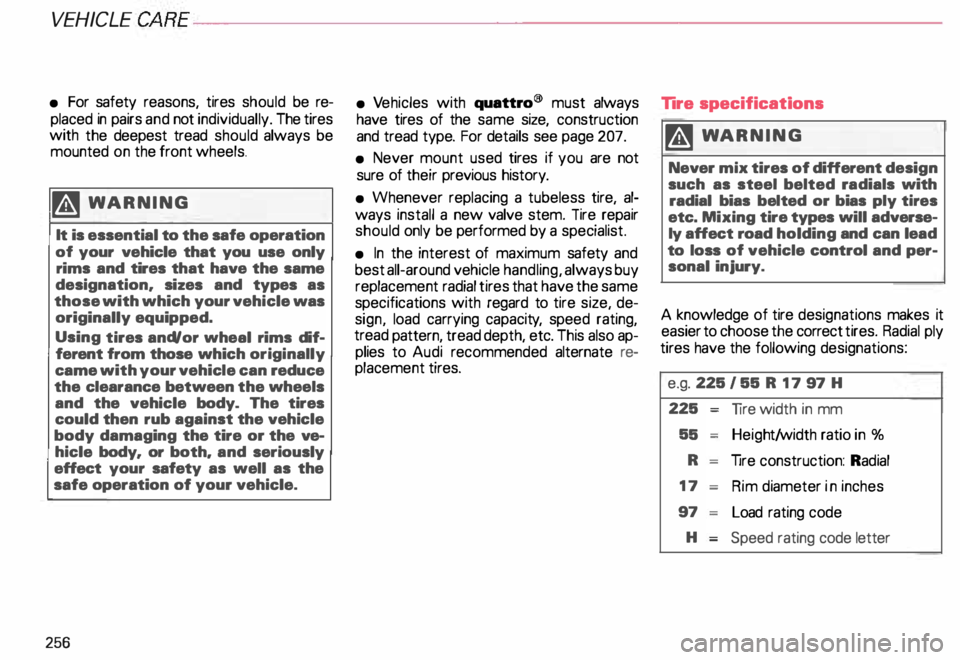
VEH
ICLE CARE----------------------------------------------------
• For safety reasons, tires should be re
placed in pairs and not individually. The tires
with the deepest tread should always be
mounted on the front wheels.
�W ARNING
It is essential to the safe operation
of your vehicle that you use only
rims and tires that have the same
designation. sizes and types as
those with which your vehicle was
originally equipped.
Using tires and/or wheal rims dif
ferent from those which originally
came with your vehicle can reduce
the clearance between the wheels
and the vehicle body. The tires
could then rub against the vehicle
body damaging the tire or the ve
hicle body. or both. and seriously
effect your safety as well as the
safe operation of your vehicle.
256 •
Ve hicles with quattro ® must always
have tires of the same size, construction
and tread type. For details see page 207.
• Never mount used tires if you are not
sure of their previous history.
• Whenever replacing a tubeless tire, al
ways install a new valve stem. Tire repair
should only be performed by a specialist.
• In the interest of maximum safety and
best all-around vehicle handling, always buy
replacement radial tires that have the same
specifications with regard to tire size, de
sign, load carrying capacity, speed rating,
tread pattern, tread depth, etc. This also ap
plies to Audi recommended alternate re
placement tires. Tire
specifications
�W ARNIN G
Never mix tires of different design
such as steel belted radials with
radial bias belted or bias ply tires
etc. Mixing tire types will adverse
ly affect road holding and can lead
to loss of vehicle control and per
sonal injury.
A knowledge of tire designations makes it
easier to choose the correct tires. Radial ply
tires have the following designations:
e.g. 225 /55 R 17 97 H
225 lire width in mm
55 Heig ht/width ratio in %
R lire construction: Radial
17 Rim diameter in inches
97 Load rating code
H Speed rating code letter
Page 258 of 306
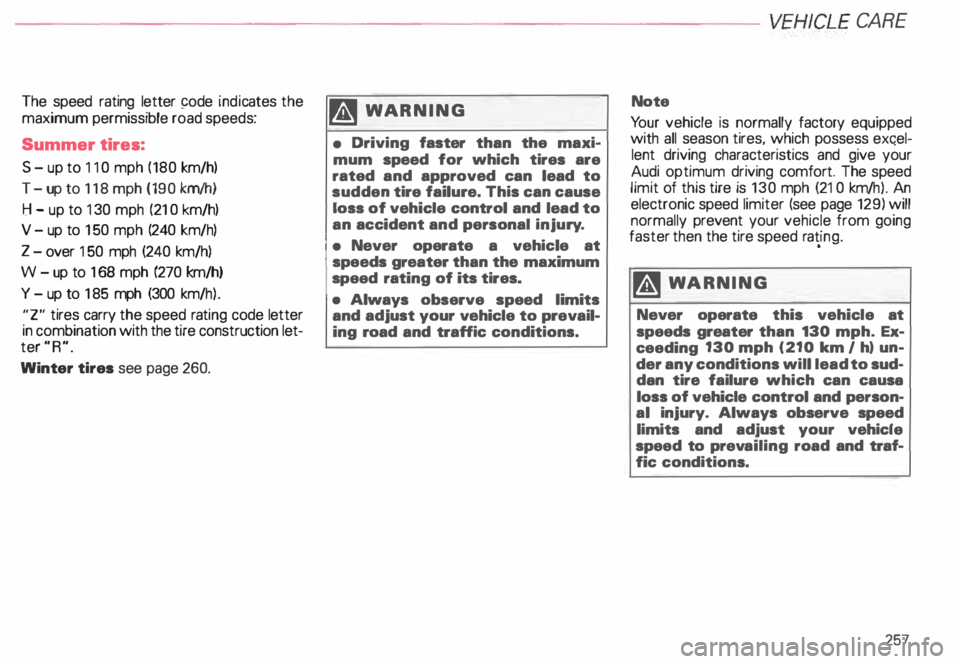
-------------------------VEHICL E
CA RE
The speed rating letter 9ode indicates the
maximum permissible road speeds:
Summer tires:
S - up to 11 0 mph (180 km/h)
T- up to 118 mph (190 km/h)
H- up to 130 mph (21 0 km/h)
V- up to 150 mph (240 km/h)
Z - over 150 mph (240 km/h)
W- up to 168 mph (270 k.m/h)
Y- up to 185 mph (300 km/h).
"Z" tires carry the speed rating code letter
in combination with the tire construction let
ter "R".
Winter tires see page 260. m
WARNING
• Driving faster than the maxi
mum speed for which tires are
rated and approved can lead to
sudden tire failure. This can cause
loss of vehicle control and lead to
an accident and personal injury.
• Never operate a vehicle at
speeds greater than the maximum
speed rating of its tires.
• Always observe speed limits
and adjust your vehicle to prevail
ing road and traffic conditions. Note
Yo ur vehicle is normally factory equipped
with all season tires. which possess excel
lent driving characteristics and give your
Audi optimum driving comfort. The speed
limit of this tire is 130 mph (21 0 km/ h). An
electronic speed limiter (see page 129) will
normally prevent your vehicle from going
faster then the tire speed ravng.
�W ARNING
Never operate this vehicle at
speeds greater than 130 mph. Ex
ceeding 130 mph (210 km I h) un
der any conditions will lead to sud
dan tire failure which can causa
loss of vehicle control and person
al injury. Always observe speed
limits and adjust your vehicle
speed to prev ailing road and traf
fic conditions.
257
Page 259 of 306
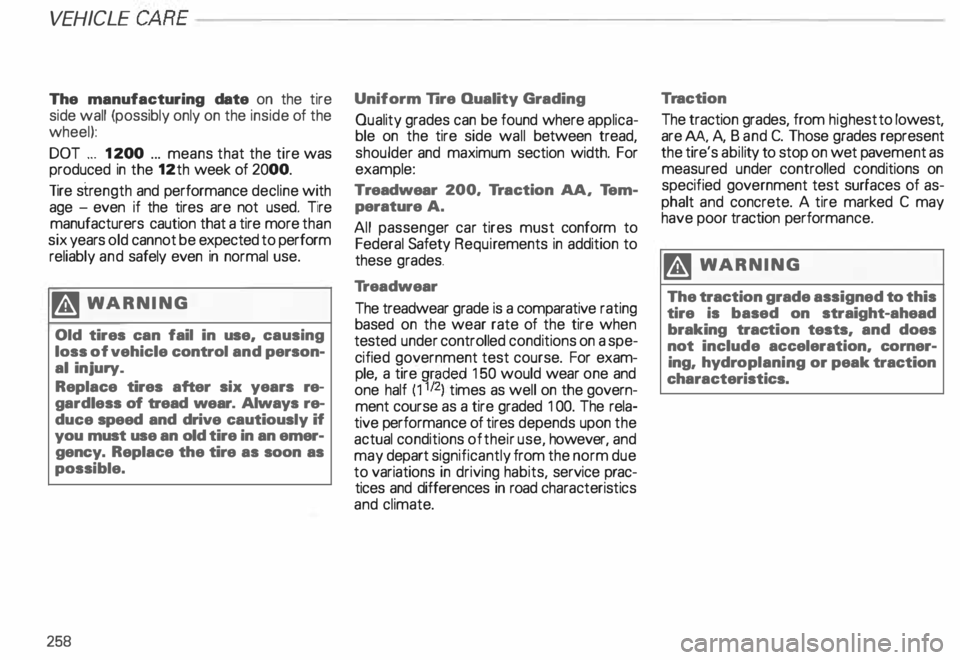
VEHICLE CA
RE--------------------------
The manufacturing date on the tire
side wall (possibly only on the inside of the
wheel):
DOT ... 12 00 ... means that the tire was
produced in the 12th week of 2000.
Tire strength and performance decline with
age -even if the tires are not used. Tire
manufacturers caution that a tire more than
six years old cannot be expected to perform
reliably and safely even in normal use.
�W ARNING
Old tires can fail in use, causing
loss of vehicle control and person
al injury.
Replace tires after six years re
gardless of tread wear. Always re
duce speed and drive cautiously if
you must use an old tire in an emer
gency. Replace the tire as soon as
possible.
258 Uniform
Tire Quality Grading
Quality grades can be found where applica
ble on the tire side wall between tread,
shoulder and maximum section width. For
example:
Treadwear 200, Traction AA, Tem
perature A.
All passenger car tires must conform to
Federal Safety Requirements in addition to
these grades.
Tr eadwear
The treadwear grade is a comparative rating
based on the wear rate of the tire when
tested under controlled conditions on a spe
cified government test course. For exam
ple, a tire
Qraded 15
0 would wear one and
one half (1112) times as well on the govern
ment course as a tire graded 1 00. The rei a·
tive perfo rmance of tires depends upon the
actual conditions of their use, however, and
may depart significantly from the norm due
to variations in driving habits, service prac
tices and differences in road characteristics
and climate. Tra
ction
The traction grades, from highest to lowest,
are AA, A, Band C. Those grades represent
the tire's ability to stop on wet pave ment as
measured under controlled conditions on
specified government test surfaces of as
phalt and concrete. A tire marked C may
have poor traction performa nce.
�W ARNING
The traction grade assigned to this
tire is based on straight-ahead
braking traction tests, and does
not include acceleration, corner
ing, hydr oplaning or peak traction
characteristics.
Page 260 of 306
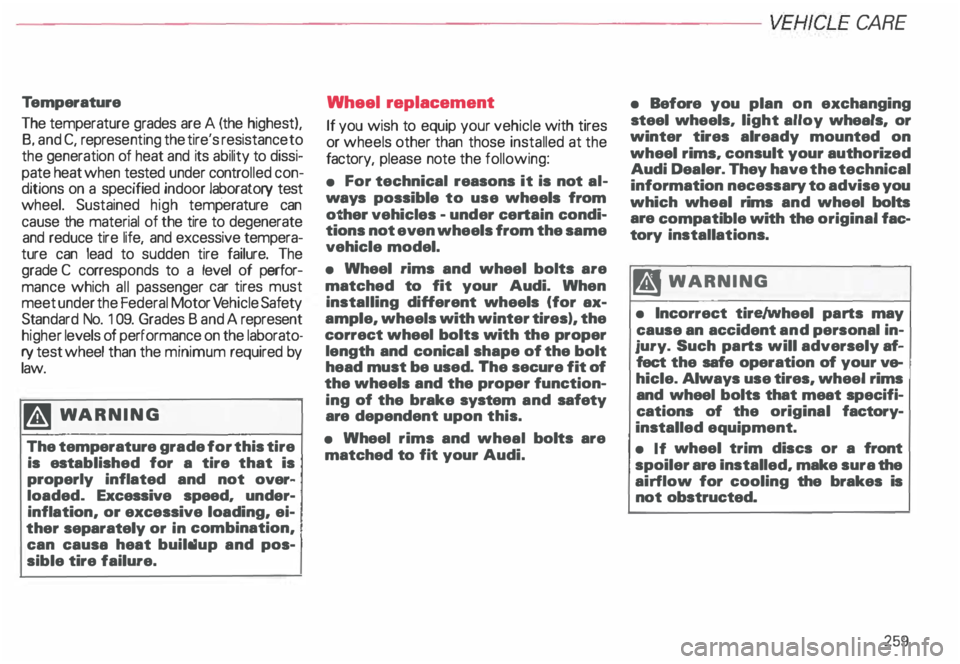
-------------------------VEHICLE
CARE
Te mperature
The temperature grades are A (the highest),
8, and C, repres enting the tire's resistance to
the generation of heat and its ability to dissi
pate heat when tested under contro lled con
ditions on a specified indoor laboratory test
wheel. Sustained high temJ)erature can
cause the material of the tire to degenerate
and reduce tire life, and excessive tempera
ture can lead to sudden tire failure. The
grade C corres ponds to a level of perfor
mance which all passenger car tires must
meet under the Federal Motor Vehicle Safety
Sta ndard No. 1 09. Grades Band A represent
higher levels of performance on the laborato
ry test wheel than the minimum required by
law.
�W ARNIN G
The temperature grade for this tire
is est ablished for a tire that is
properly inflated and not over
loaded. Excessive speed, under
inflation, or excessive loading, ei
ther separately or in combination,
can causa heat buildup and pos
sible tire failure. Wheel
replacement
If you wish to equip your vehicle with tires
or wheels other than those installed at the
factory, please note the following:
• For technical reasons it is not al
ways possible to use wheels from
other vehicles -under certain condi
tions not even wheels from the same
vehicle model.
• Wheel rims and wheel bolts are
matched to fit your Audi. When
installing different wheels (for ax
ample, wheels with winter tires), the
correct wheel bolts with the proper
length and conical shape of the bolt
head must be used. The secure fit of
the wheels and the proper function
ing of the brake system and safety
are dependent upon this.
• Wheel rims and wheal bolts are
matched to fit your Audi. •
Before you plan on exchanging
steel wheels, light alloy wheals, or
winter tires already mounted on
wheel rims, consult your authorized
Audi Dealer. They have the technical
information necessary to advise you
which wheal rims and wheel bolts
are compatible with the original fac
tory installations.
1ft WARNING
• Incorrect tire/wheel parts may
cause an accident and personal in
jury. Such parts will adversely af
fect the safe operation of your ve
hicle. Always use tires, wheel rims
and wheel bolts that meat specifi
cations of the original factory
installed equipment.
• If wheel trim discs or a front
spoiler are Installed, make sura the
airflow for cooling the brakes is
not obstructed.
259